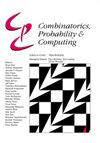The chromatic profile of locally colourable graphs
IF 0.8
4区 数学
Q3 COMPUTER SCIENCE, THEORY & METHODS
引用次数: 2
Abstract
The classical Andrásfai-Erdős-Sós theorem considers the chromatic number of $K_{r + 1}$ -free graphs with large minimum degree, and in the case, $r = 2$ says that any n-vertex triangle-free graph with minimum degree greater than $2/5 \cdot n$ is bipartite. This began the study of the chromatic profile of triangle-free graphs: for each k, what minimum degree guarantees that a triangle-free graph is k-colourable? The chromatic profile has been extensively studied and was finally determined by Brandt and Thomassé. Triangle-free graphs are exactly those in which each neighbourhood is one-colourable. As a natural variant, Luczak and Thomassé introduced the notion of a locally bipartite graph in which each neighbourhood is 2-colourable. Here we study the chromatic profile of the family of graphs in which every neighbourhood is b-colourable (locally b-partite graphs) as well as the family where the common neighbourhood of every a-clique is b-colourable. Our results include the chromatic thresholds of these families (extending a result of Allen, Böttcher, Griffiths, Kohayakawa and Morris) as well as showing that every n-vertex locally b-partite graph with minimum degree greater than $(1 - 1/(b + 1/7)) \cdot n$ is $(b + 1)$ -colourable. Understanding these locally colourable graphs is crucial for extending the Andrásfai-Erdős-Sós theorem to non-complete graphs, which we develop elsewhere.局部可着色图的彩色轮廓
经典的Andrásfai-Erdős-Sós定理考虑了具有大最小度的$K_{r + 1}$自由图的色数,在这种情况下,$r = 2$表示任何最小度大于$2/5 \cdot n$的n顶点无三角形图是二部图。这开始了对无三角形图的彩色轮廓的研究:对于每k,保证无三角形图可k色的最小度是多少?人们对彩色轮廓进行了广泛的研究,并最终由勃兰特和托马斯·索瑟尔确定。无三角形图就是那些每个邻域都是单色的图。作为一个自然的变体,Luczak和thomass引入了局部二部图的概念,其中每个邻域都是2色的。本文研究了每个邻域都是b可色的图族(局部b部图)和每个a团的公共邻域都是b可色的图族的色轮廓。我们的结果包括这些族的色阈值(扩展了Allen, Böttcher, Griffiths, Kohayakawa和Morris的结果),并表明每个最小度大于$(1 - 1/(b + 1/7)) \cdot n$的n顶点局部b-部图$(b + 1)$ -可着色。理解这些局部可着色图对于将Andrásfai-Erdős-Sós定理扩展到我们在其他地方开发的非完全图是至关重要的。
本文章由计算机程序翻译,如有差异,请以英文原文为准。
求助全文
约1分钟内获得全文
求助全文
来源期刊

Combinatorics, Probability & Computing
数学-计算机:理论方法
CiteScore
2.40
自引率
11.10%
发文量
33
审稿时长
6-12 weeks
期刊介绍:
Published bimonthly, Combinatorics, Probability & Computing is devoted to the three areas of combinatorics, probability theory and theoretical computer science. Topics covered include classical and algebraic graph theory, extremal set theory, matroid theory, probabilistic methods and random combinatorial structures; combinatorial probability and limit theorems for random combinatorial structures; the theory of algorithms (including complexity theory), randomised algorithms, probabilistic analysis of algorithms, computational learning theory and optimisation.
 求助内容:
求助内容: 应助结果提醒方式:
应助结果提醒方式:


